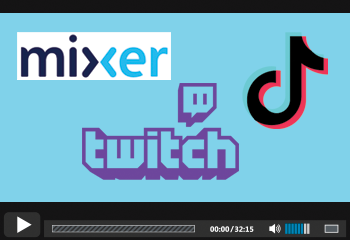If it’s between 9:30 am and 6 pm CST, a 28-year-old named Tyler Blevins—better known as Ninja—is most likely broadcasting himself playing video games. He’s also making an estimated $500,000 a month doing it.

Blevins represents the new wave of visual entertainment and video game streaming. His popularity started to soar in late 2017 when he and other video game streamers began playing a game called Fortnite. Fast forward to 2019, and Blevins is now the most recognized name in the video game streaming industry with nearly 15 million followers.
If You Build It They Will Come imageBut it’s not just Blevins and the video game streaming industry that are racking up huge audiences. The entire streaming industry is estimated to reach $125 billion by 2025, according to findings from Grand View Research.
Here are three of the most popular social media platforms that are currently dominating the live, visual entertainment market.
- Twitch: Live game streaming
Twitch (purchased by Amazon in 2014 for $1 billion) is the most popular streaming (sharing live video) platform in the world and where Blevins first started growing his followers. It has 15 million daily active users and 27,000 partners—streamers who have met certain conditions to access more features and monetize their channels. Twitch is most associated with watching people play video games, but has everything from live educational streams to broadcasting events for eSports, an industry with revenues over $1 billion. While users are attracted to the service by individual gamers and the games they play, Twitch relies on an audience in the 18- to 34-year-old age range to patronize advertisers, make in-app purchases, and subscribe to premium services. - Mixer: Microsoft competitor to Twitch
Purchased by Microsoft in 2016 for an undisclosed amount, Mixer is currently a distant 2nd to Twitch in the streaming space, but quickly gaining traction. Boasting a better overall gaming and watching experience than Twitch, Mixer was able to lure Blevins away from Twitch in 2019, signing him to a $50 million contract. Like Twitch, Mixer is banking on both establishment backing and being able to move traditional revenue streams into a new model. - TikTok: The lip-synching video phenomena
If video games aren’t your thing, then maybe lip-synching with TikTok is worth a look. Backed by the Chinese company ByteDance, TikTok’s app boasts 150+ million downloads across every major market in the world, a level of adoption only matched by the biggest names in tech. TikTok lets users create 15-second videos and share them, and then the platform uses advanced artificial intelligence (AI) to directly feed those videos to users it deems will enjoy them. This is different than apps which suggest content, as TikTok directly presents the content to users. Videos are often of individuals participating in viral dance trends or of short comedic skits. The AI behind the app is constantly learning from user videos and is able to better curate content.
While these new forms of visual entertainment are not necessarily something you wish to spend time viewing, knowing what is happening with your kids and grandchildren makes sense for all of us.


